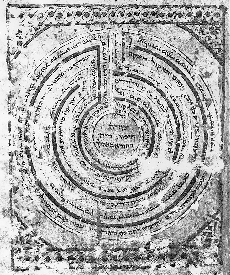| Through Mazes |
 |
to Mathematics |
| Through Mazes |
 |
to Mathematics |
This page has been translated into Polish.
This page has been translated into Romanian.
This page has been translated into Spanish.
A short time later I was visiting the house of David Gay, a mathematician
at the University of Arizona in Tucson. Hanging on
the wall was a flat basket, about 18 inches in diameter, woven
with a design that turned out to be
topologically identical to the Cretan
maze. David told me that this basket design is
traditional with the Tohono Oʼodham (formerly "Papago")
Indians, a tribe living now in northern
Arizona, and that the twists and turns of the path through the maze
represent events and trials in the life of the hero Iitoi shown at
the entrance.

Although this maze has a superficial resemblance to the Cretan maze, a close comparison shows they are quite different. The Jericho maze has 7 levels, whereas the Cretan maze has 8, and the sequence in which the levels are reached is quite different from one maze to the other. In both mazes the path goes directly to level 3 (counting the outside as 0) but in the Cretan maze it then doubles back through levels 2 and 1, whereas in the Jericho maze it continues on through levels 4 and 5 before returning to 2 and 1. The complete level sequences are
Cretan 0 3 2 1 4 7 6 5 8
Jericho 0 3 4 5 2 1 6 7.
These can be interpreted as musical phrases, letting 0 = C, 1 = D, etc. The ear detects immediately that in the Cretan tune, the initial phrase is repeated in a higher pitch; as I later understood, this maze can be decomposed into the product or stacking of two copies of the four-level maze 03214.
Having seen two similar but distinct examples, I began to wonder how many more there might be. The first thing was to understand exactly what they had in common. It turns out that there are three characteristics that they share, and that define a class of mazes that can be investigated mathematically: these are the simple, alternating, transit mazes. I became interested in the problem of determining $M_n$, the number of distinct s.a.t. mazes with $n$ levels.

I then began to search for a way of computing $M_n$. The method I had been using was not practical for larger values of $n$, since it involved looking at a number of pairs of permutations that increased, roughly, like $((n/2)!)^2$. To compute $M_{20}$, for example, would require examination of about $10^{13}$ pairs, which would take a long time even on a very fast computer. Help arrived from an unexpected source.
This was the first I had ever heard of the stamp-folding problem, but it is clearly related to the problem of counting mazes. In fact each maze of depth $n$ gives a way of folding a strip of $n+1$ stamps: put the maze in rectangular form and lay the stamps along the maze-path, one on each level (including 0 and $n$), ignoring the vertical segments. But there is a difference: the first and last stamps of a folded strip may have their free edges embedded in the interior of the packet, while the first level (after 0) and the last level (before $n$) of a maze-path must have their free ends on the outside. So if $F_n$ is the number of ways of folding a strip of $n$ stamps, we can only conclude that $M_n < F_{n+1}$.
The calculation of $F_n$ was done by John E. Koehler, S. J. for $n\leq 16$ in an article published in 1968. The numbers start as above and go up to $F_{16} = 4215768$. But what was most useful was that Koehler described a way of counting foldings of a strip of $n$ stamps ($n$ even) by looking at pairs of "$n$-patterns;" and the number of distinct $n$-patterns was available in closed form, for $n$ even: it was the $(n/2)$-th Catalan number $\mbox{Cat}(n/2)$. S.a.t. mazes with $n$ levels admit a similar enumeration; in this case the two $n$-patterns must satisfy the additional condition that guarantees a single path threading the entire maze. Now the Catalan numbers, even though they are defined with factorials, only grow exponentially; in fact $$ \mbox{Cat}(k) \sim 4^k k^{-3/2} \pi^{-1/2}$$ for $k$ large, an easy consequence of Stirling's formula. It follows that since every $n$-level maze corresponds to a pair of $n$-patterns, the number $M_n$ of $n$-level mazes ($n$ even) is $< \mbox{Cat}(n/2)^2$, and so grows at most exponentially.
More practically, there are many fewer pairs of $n$-patterns than pairs of permutations of $n/2$ elements, and Koehler's identification allowed me to compute $M_n$ through $n=22$ for $n$ even, by checking all pairs of $n$-patterns for the single-cycle property. Of course the calculation time still increases exponentially with $n$. For $n = 22$ the number of pairs of $n$-patterns to be examined was $\mbox{Cat}(11)^2 = 3455793796$. This took some 73 hours on a Sun-3 computer. The $n = 24$ calculation would take roughly 16 times as long, etc.
Jim Reeds of Bell Labs found a better method and was able to extend the calculation to $n = 28$.
One by-product of my study of these maze patterns was the
realization that the maze-makers of ancient times worked by
combining a limited number of fundamental forms. This allowed
me to suggest how partially destroyed Roman mosaic mazes
should be restored, and to detect some examples of faulty
restoration in those already repaired. See
The topology of Roman mosaic mazes.
Return to Main Maze Page
Return to Tony's Home Page